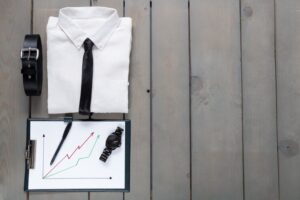A Complete Guide to Business Casual for Men

In today’s work environment, understanding what to wear is crucial, especially when it comes to business casual attire for men. Business casual has become a popular dress code in many workplaces because it allows employees to look professional while still being comfortable. However, the definition of business casual can vary greatly from one organization to another. This guide will help you navigate the world of business casual attire, ensuring you make the right choices for interviews, meetings, and everyday work life.
What Is Business Casual?
Business casual is a style of dress that is less formal than traditional business wear, such as suits and ties, but still maintains a professional appearance. The aim is to present yourself in a way that is polished and appropriate for the workplace. This attire is common in various industries, including tech, finance, and creative sectors. However, what is considered business casual can differ based on the company’s culture, your position, and even the specific industry you work in.
Key Elements of Business Casual Attire

Shirts
A good starting point for business casual attire is your shirt. Here are some options:
- Button-Down Shirts: These are often considered a staple of business casual wear. Choose solid colors or subtle patterns to maintain a professional look.
- Polo Shirts: Polo shirts with a collar are generally acceptable in many business casual environments. They are comfortable and can be paired with dress pants or chinos.
- Sweaters: A neat sweater over a button-down shirt can provide warmth while still looking professional. Stick to neutral or muted colors.
Pants
When it comes to pants, you have a variety of choices:
- Dress Pants: Tailored dress pants in colors like navy, grey, or black are a safe choice. They give a polished look without being overly formal.
- Khakis or Chinos: These pants are a great option for a more relaxed style. They can be paired with both button-down shirts and polo shirts.
- Jeans: In some workplaces, clean and dark-wash jeans are acceptable as business casual. However, avoid ripped or overly casual jeans. Pair them with a smart shirt to elevate your look.
Footwear
Your choice of shoes can make or break your business casual outfit:
- Dress Shoes: Classic options like loafers, oxfords, or brogues are typically ideal for business casual attire. They provide a refined touch to your outfit.
- Smart Sneakers: Some companies allow more casual footwear, such as clean and professional-looking sneakers. Ensure they are in good condition and not too flashy.
- Avoid Flip-Flops: Always steer clear of overly casual shoes like flip-flops or slides, as they can detract from a professional appearance.
Accessories
Accessories play a crucial role in completing your business casual look:
- Belts: A good belt is essential. Match your belt color with your shoes for a cohesive look.
- Watches: Wearing a nice watch can add a touch of sophistication. Avoid overly flashy designs and opt for something simple and elegant.
- Ties: Ties are generally not necessary in a business casual setting, but if you want to add one for an important meeting, choose a simple and understated style.
Tips for Choosing Business Casual Attire

Know Your Company’s Dress Code
Understanding your company’s dress code is vital. While some organizations have a relaxed approach, others may expect a more polished appearance. If you’re unsure, it’s a good idea to observe what your colleagues are wearing, especially those in similar roles.
Dress for Your Role
Your position can influence your business casual choices. For example, a manager might opt for more formal attire compared to a junior employee. When meeting with clients or attending important meetings, consider dressing up a bit more to project professionalism.
Consider the Industry
Different industries have varying expectations for business casual attire. For instance, tech companies often have a more relaxed dress code compared to finance or legal firms. Research the industry standards to ensure you’re dressing appropriately.
Pay Attention to Fit
Regardless of the clothing you choose, fit is crucial. Ensure your clothes fit well and are not too baggy or tight. Tailored clothing can enhance your appearance and boost your confidence.
Keep It Simple
While it’s great to express your style, keep it simple and avoid overly flashy patterns or colors. Neutral colors and classic styles are typically safer choices in a business casual setting.
Conclusion
Navigating the world of business casual attire for men doesn’t have to be daunting. By understanding what constitutes business casual and considering factors such as your company culture, industry, and personal style, you can create a wardrobe that reflects professionalism and comfort. Remember, the key to a successful business casual outfit is balance. Aim for a look that makes you feel confident while also being appropriate for your workplace. With these tips, you’ll be well on your way to mastering business casual attire and making a great impression at work.
FAQs
1. What is the difference between business casual and business professional?
Business casual is less formal than business professional attire. Business professional typically includes suits, ties, and dress shoes, while business casual may include dress pants, polo shirts, and smart shoes. The goal of business casual is to look polished yet comfortable.
2. Are jeans acceptable for business casual attire?
Yes, jeans can be acceptable in business casual settings, but they should be clean, dark-wash, and free of rips or frays. It’s essential to pair them with a smart shirt and appropriate shoes to maintain a professional appearance.
3. Can I wear sneakers with business casual attire?
In some workplaces, clean and professional-looking sneakers are allowed as part of business casual attire. However, it’s best to avoid overly casual sneakers and opt for styles that are sleek and polished.
4. Is it necessary to wear a tie in business casual settings?
No, wearing a tie is generally not required in business casual settings. However, if you have an important meeting or presentation, wearing a tie can be a good way to elevate your outfit and make a stronger impression.



